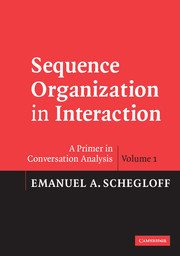Book contents
- Frontmatter
- Contents
- Preface
- Acknowledgments
- 1 Introduction to sequence organization
- 2 The adjacency pair as the unit for sequence construction
- 3 Minimal, two-turn adjacency pair sequences
- 4 Pre-expansion
- 5 The organization of preference/dispreference
- 6 Insert expansion
- 7 Post-expansion
- 8 Topic-proffering sequences: a distinctive adjacency pair sequence structure
- 9 Sequence-closing sequences
- 10 Sequences of sequences
- 11 Retro-sequences
- 12 Some variations in sequence organization
- 13 Sequence as practice
- 14 Summary and Applications
- Appendix 1 Conversation-analytic transcript symbols
- Appendix 2 Transcript of a telephone call
- References
- Index
6 - Insert expansion
Published online by Cambridge University Press: 05 September 2012
- Frontmatter
- Contents
- Preface
- Acknowledgments
- 1 Introduction to sequence organization
- 2 The adjacency pair as the unit for sequence construction
- 3 Minimal, two-turn adjacency pair sequences
- 4 Pre-expansion
- 5 The organization of preference/dispreference
- 6 Insert expansion
- 7 Post-expansion
- 8 Topic-proffering sequences: a distinctive adjacency pair sequence structure
- 9 Sequence-closing sequences
- 10 Sequences of sequences
- 11 Retro-sequences
- 12 Some variations in sequence organization
- 13 Sequence as practice
- 14 Summary and Applications
- Appendix 1 Conversation-analytic transcript symbols
- Appendix 2 Transcript of a telephone call
- References
- Index
Summary
One upshot of our discussion of the organization of preference and dispreference was that the production of a sequence whose first and second pair parts are in a preferred relationship to each other is something which both parties – an F speaker and an S speaker – can be oriented to and can take measures to achieve (although they do not always achieve it). We noted, for example, that first pair part speakers can re-do a question to reverse its displayed preference so that the response which seems to be “in the cards” can be done by its speaker as an agreeing or preferred response rather than a dispreferred one, and that the practice of deferring dispreferred responses can provide the opportunity for just such a redesign of the first pair part. In this light, we could understand pre-expansions as resources which a prospective F-speaker can initiate to implement an orientation to the possibility of a dispreferred response, and whose outcome can ground moves to proceed to the first pair part or not, and what type of first pair part and how constructed. Like pre-expansions, many insert expansions are oriented to issues of preference and dispreference, but that is not their universal preoccupation.
With insert expansions, we come to a type of expansion which prospective S-speakers can initiate. Insert expansions, like pre-expansions, are themselves constructed out of adjacency pairs and take the form of insert sequences.
- Type
- Chapter
- Information
- Sequence Organization in InteractionA Primer in Conversation Analysis, pp. 97 - 114Publisher: Cambridge University PressPrint publication year: 2007

